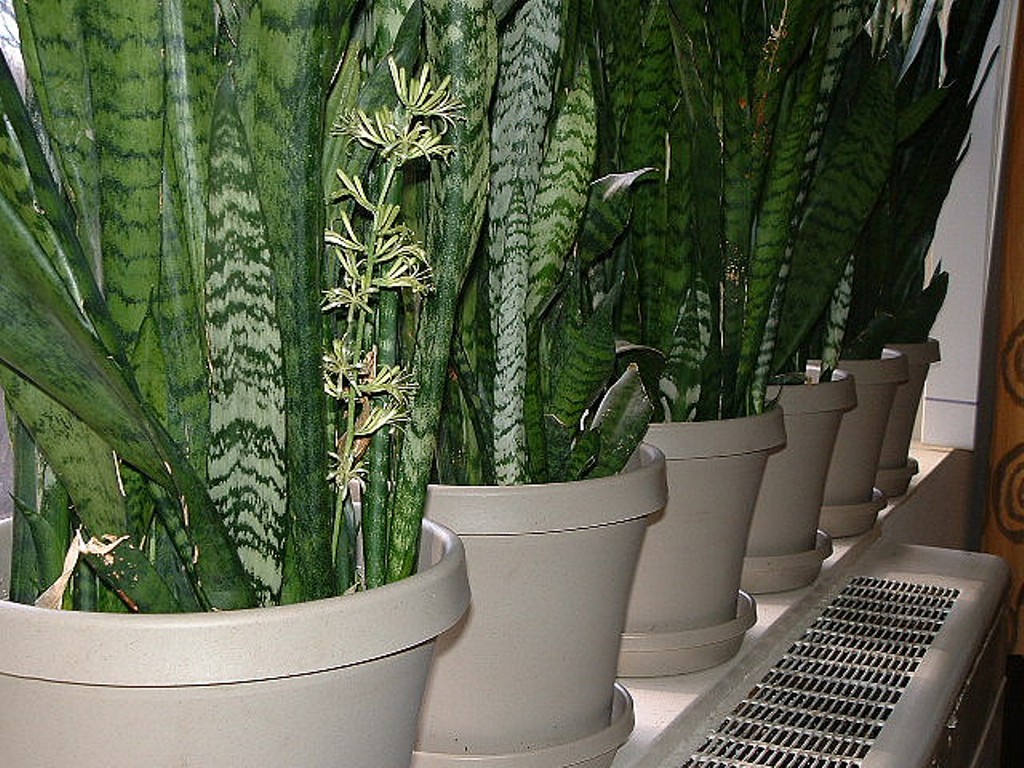Table of Contents:
Photo by Kara Reuter
Snake plants received their name from the shape of their leaves, and are also called Mother-in-Law Tongues due to their sharpness. They can be successfully grown by even those with the blackest of thumbs. The striking foliage shoots straight up for several feet if allowed to grow to maximum heights. Whether looking for a touch of green for your home or office, this plant brighten up the room and can help clean the air too!
Before You Plant
Choose the Right Type:
There are over 30 varieties of snake plants available. Though they each have the same general shape, the variegated foliage with silvery-white or yellow stripes on the leaf margins give them each a unique look.
Popular varieties to look for include:
- Goldiana
- Compacta
- Silbersee
- Hahnii
- Laurentii
- Silver Hahnii
Find a Suitable Place:
- Snake plants will grow just about anywhere. They can grow fine with very little light, as long as they are not in complete darkness, but they prefer low to moderate indirect light. Keep them away from direct sunlight as it will damage their leaves.
- Warmer temperatures are ideal during the daytime, between 68° and 85° Fahrenheit. Nighttime temperatures can be slightly lower, between 58° to 75° Fahrenheit.
Prepare the Soil:
- Snake plants do not require special soil. Any well-draining potting mix that allows the soil to remain moist will work well for growing these plants indoors.
Planting/Growing
What You Will Need:
- Snake plants
- Potting Soil
- Small shovel
- Fertilizer
- Room temperature water
Steps for Growing Snake Plants:
- Snake plants are a common houseplant that can be purchased from any home/garden center or nursery. They are available in smaller sizes (3 inches) all the way up to larger plants (14 inches). Most plants come in containers that allow for adequate growth and do not need to be transplanted. However, if your plant is purchased in a small, starter container and needs to be moved to a larger container, it’s easy to do.
- Begin by removing the plant from the original container.
- Slightly loosen any tightly-bound sections of the roots and place into a larger container filled with potting soil. Try to keep the plant at the same depth as it was in the original container.
- Fill in with additional potting soil until the container is filled to one inch from the top and pat gently to firm.
- Water thoroughly after the initial transplant and place in its permanent location.
- Allow the soil become slightly dry between waterings. Typically, you will only need to water these plants every 7-10 days. Even the most neglected plants seem to hang on and grow just fine.
- The foliage will show if it is receiving enough water. Too little water – the leaves will start to wrinkle or bend over. Too much water and the leaves will start to droop. Simply adjust the amount of water and it should return to normal. If leaves are too damaged, simply cut them off.
- Very little fertilizer is necessary for these plants to grow. If you choose to fertilize, use a mild fertilizer that has been diluted. Fertilize according to the instructions on the lable, but be cautious not to over-fertilize.
Propagation of New Plants
By Division:
- Snake plants can be divided at any time during the year.
- Remove the plant from the container and separate it into sections. Pull it apart if possible, or you may have to cut it apart. Be sure to keep roots and leaves in each section.
- Plant each section in a fresh pot that is large enough to support new growth. Try to plant it at the same depth it was in the original container.
- Water well immediately after planting and care for the same as you would an established plant (except for the fertilizer – do not fertilize for at least three months).
With Cuttings:
- New plants can easily be propagated with cuttings year round.
- Begin by removing a leaf from the plant.
- Place the end of the leaf into a glass of water or a small pot filled with fresh soil. Keep it here until roots begin to grow.
- If rooted in water, transplant to a pot filled with potting soil after the roots are established.
Additional Tips and Advice
- Snake plants do produce blooms, but they do not offer the pleasant smell one might expect. Be cautious not to stay too close to these pungent flowers as many find the smell nauseating.
- If the leaves grow too tall, simply cut them back to the desired height.
- Though beautiful, all parts of this plant are poisonous if ingested, so it’s best for homes without children or pets.
- Did you know? The strong fibers of the leaves were once used to make bow strings.
Related Posts
No related posts.
